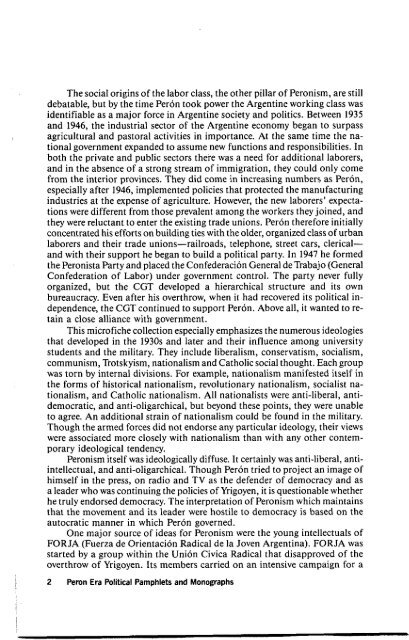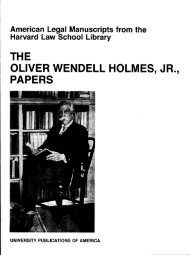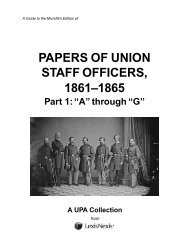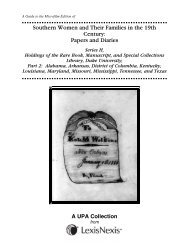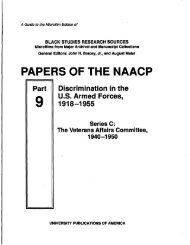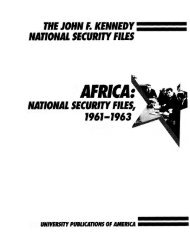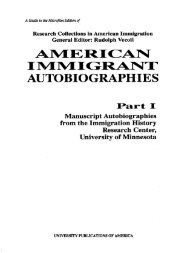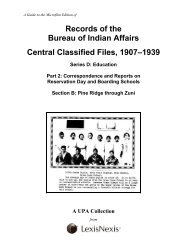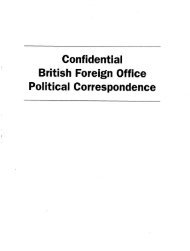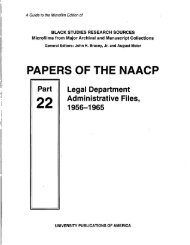PERON ERA POLITICAL PAMPH - ProQuest
PERON ERA POLITICAL PAMPH - ProQuest
PERON ERA POLITICAL PAMPH - ProQuest
You also want an ePaper? Increase the reach of your titles
YUMPU automatically turns print PDFs into web optimized ePapers that Google loves.
The social origins of the labor class, the other pillar of Peronism, are still<br />
debatable, but by the time Peron took power the Argentine working class was<br />
identifiable as a major force in Argentine society and politics. Between 1935<br />
and 1946, the industrial sector of the Argentine economy began to surpass<br />
agricultural and pastoral activities in importance. At the same time the national<br />
government expanded to assume new functions and responsibilities. In<br />
both the private and public sectors there was a need for additional laborers,<br />
and in the absence of a strong stream of immigration, they could only come<br />
from the interior provinces. They did come in increasing numbers as Peron,<br />
especially after 1946, implemented policies that protected the manufacturing<br />
industries at the expense of agriculture. However, the new laborers' expectations<br />
were different from those prevalent among the workers they joined, and<br />
they were reluctant to enter the existing trade unions. Peron therefore initially<br />
concentrated his efforts on building ties with the older, organized class of urban<br />
laborers and their trade unions--railroads, telephone, street cars, clerical-and<br />
with their support he began to build a political party. In 1947 he formed<br />
the Peronista Party and placed the Confederaci6n General de Trabajo (General<br />
Confederation of Labor) under government control. The party never fully<br />
organized, but the CGT developed a hierarchical structure and its own<br />
bureaucracy. Even after his overthrow, when it had recovered its political independence,<br />
the CGT continued to support Peron. Above all, it wanted to retain<br />
a close alliance with government.<br />
This microfiche collection especially emphasizes the numerous ideologies<br />
that developed in the 1930s and later and their influence among university<br />
students and the military. They include liberalism, conservatism, socialism,<br />
communism, Trotskyism, nationalism and Catholic social thought. Each group<br />
was torn by internal divisions. For example, nationalism manifested itself in<br />
the forms of historical nationalism, revolutionary nationalism, socialist nationalism,<br />
and Catholic nationalism. All nationalists were anti-liberal, antidemocratic,<br />
and anti-oligarchical, but beyond these points, they were unable<br />
to agree. An additional strain of nationalism could be found in the military.<br />
Though the armed forces did not endorse any particular ideology, their views<br />
were associated more closely with nationalism than with any other contemporary<br />
ideological tendency.<br />
Peronism itself was ideologically diffuse. It certainly was anti-liberal, antiintellectual,<br />
and anti-oligarchical. Though Peron tried to project an image of<br />
himself in the press, on radio and TV as the defender of democracy and as<br />
a leader who was continuing the policies of Yrigoyen, it is questionable whether<br />
he truly endorsed democracy. The interpretation of Peronism which maintains<br />
that the movement and its leader were hostile to democracy is based on the<br />
autocratic manner in which Peron governed.<br />
One major source of ideas for Peronism were the young intellectuals of<br />
FORJA (Fuerza de Orientation Radical de la Joven Argentina). FORJA was<br />
started by a group within the Union Civica Radical that disapproved of the<br />
overthrow of Yrigoyen. Its members carried on an intensive campaign for a


